My diary
Day 1 - 29 Apr 14
I arrive in Jakarta 3 hours late, as the plane had landed midway in the desert in India due to someone falling ill. The smells and humidity typical of South East Asia engulf me as I walk out of the airport. Hannah is still searching the airport for me as the airport's computer system showed that the plane arrived on time. We taxi into Jakarta to Six Degrees - a clean, modern hostel, with pods for beds.
We sit at a street stall for dinner with the 2 Swiss boys who share our room. The spicy Mie Goreng is delicious. We drink a beer on the hostel's rooftop garden before bed. One of the Swiss boys shares his recent stories from journeying through Sumatra. He was born with arm deformities but this has not stopped him from travelling independently. We are in awe of his dexterity - no wonder he finds it ridiculous that we are unable to open a beer bottle with a lighter when he is able to unscrew the top of a water bottle with no fingers.
Day 2 - 30 Apr 14
We move to Gondia International Guesthouse as the hostel is fully booked tonight. Gondia is clean and houses a small courtyard. We lunch in an open-air food court (Goen Sirih) and try beans and tofu dishes. The food is flavoursome, but a little cold. We wander south to the flea market - a street of shabby shops selling 'antiques', bags and old records. We take a tuk tuk to the small park in central Jakarta and relax on the grass for a few minutes. We are approached by a few different groups of teenagers who request photos. Hannah rightly points out that it probably doesn't help that we are standing in front of Jakarta's tallest landmark! As we exit the park, we are accosted by a few young policemen patrolling the area. They want to practice their English and of course to take a photo too.
We spend the evening planning our route to the next destination and we eat street food for dinner. Back at the guesthouse a Dutchman and his son offer us beers. He is half Indonesian and holidays in Indonesia annually but this is the first year he has brought his son with him. They write down food recommendations for us.
Arrival in Jakarta, Pangandaran, Jogjakarta, Malang
Java, Indonesia
Day 1 - 29 Apr 14
I arrive in Jakarta 3 hours late, as the plane had landed midway in the desert in India due to someone falling ill. The smells and humidity typical of South East Asia engulf me as I walk out of the airport. Hannah is still searching the airport for me as the airport's computer system showed that the plane arrived on time. We taxi into Jakarta to Six Degrees - a clean, modern hostel, with pods for beds.
We sit at a street stall for dinner with the 2 Swiss boys who share our room. The spicy Mie Goreng is delicious. We drink a beer on the hostel's rooftop garden before bed. One of the Swiss boys shares his recent stories from journeying through Sumatra. He was born with arm deformities but this has not stopped him from travelling independently. We are in awe of his dexterity - no wonder he finds it ridiculous that we are unable to open a beer bottle with a lighter when he is able to unscrew the top of a water bottle with no fingers.
Day 2 - 30 Apr 14
We move to Gondia International Guesthouse as the hostel is fully booked tonight. Gondia is clean and houses a small courtyard. We lunch in an open-air food court (Goen Sirih) and try beans and tofu dishes. The food is flavoursome, but a little cold. We wander south to the flea market - a street of shabby shops selling 'antiques', bags and old records. We take a tuk tuk to the small park in central Jakarta and relax on the grass for a few minutes. We are approached by a few different groups of teenagers who request photos. Hannah rightly points out that it probably doesn't help that we are standing in front of Jakarta's tallest landmark! As we exit the park, we are accosted by a few young policemen patrolling the area. They want to practice their English and of course to take a photo too.
We spend the evening planning our route to the next destination and we eat street food for dinner. Back at the guesthouse a Dutchman and his son offer us beers. He is half Indonesian and holidays in Indonesia annually but this is the first year he has brought his son with him. They write down food recommendations for us.
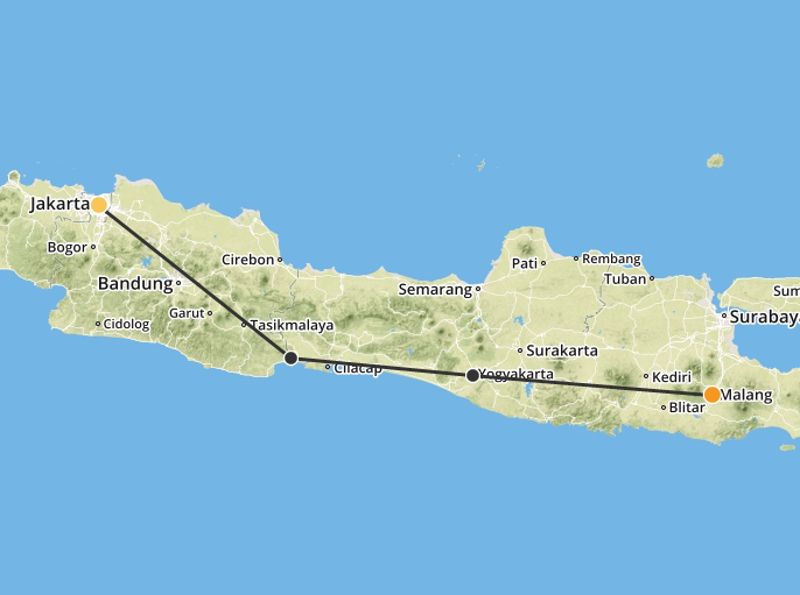
Day 3 - 1 May 14
We wake at 5 and walk from the hostel to the local train station Gondangia. The metro is much cleaner than the tubes in London. We change at Cawang to catch the Busway. A local policeman helpfully informs us that we can get a refund for part of our ticket. The Busway is a fast lane on the motorway. A lady at the bus stop writes down the stop we need to change at. Hannah mistakenly hops on the wrong bus, but realises just in time and leaps off the bus as the doors are closing and the bus is already moving away from the platform - two locals are on hand to grab her hands. We change at Cawang BNN and head to the bus terminal outside Jakarta (Kampung Rambutan). A helpful man leads us to the correct bus. We catch the 7am straight through to Pangandaran. A friendly Indonesian shares his breakfast with us - it is similar to a chocolate brioche. The bus is sweltering - comatosed by the heat, we sleep through the majority of the 8 hr journey, waking only for lunch on the side of the road. We eat noodle soup with 2 strange jelly like meatballs (bakso), which we take note to avoid in future.
Arriving in Pangandaran, we take a tuk tuk to Mini Tiga Hostel. It has an extremely friendly, welcoming atmosphere. We watch the sunset with a 'lumpy' cappuccino (it is made from a sachet disappointingly) on the beach. For dinner, we join the other hostel guests at a fish restaurant where we choose our fish - the food is delicious but over my budget.
Day 4 - 2 May 14
Today we have booked ourselves onto the tour to the Green Valley and Green Canyon along with the other travelers at the hostel. We set off at 9 am on the back of motorbikes, riding on a narrow dirt track through paddy fields and palm trees.
The tour stops at a house where a man carves puppets out of balsa wood - wayang golek. He introduces us to a famous character in Javan mythology - a handsome, strong and noble man who has 42 wives. We are fed coconut water straight from the coconut tree. Some of us attempt to climb it as footholds are hacked out of the bark.
We reach the Green Valley, a little hesitant to start after being informed by our guide that most tours will provide helmets and a life jacket, which we don't need... but if we do not listen to his instructions, it could be fatal.
The current is strong. We swim upstream into a cave, the roof covered in stalactites. We are warned not to mind the crabs - they are small and they don't bite. On hearing this, I propel myself back out into the daylight as fast as I can, shrieking irrationally. We continue downstream, walking or swimming with the current, and jumping into the pools beneath where the river meets the next small waterfall.
In order to enter a small cave behind one waterfall, we have to dip our heads under water for a short breath hold. Inside we tread water listening to the clamorous thundering of its cascade. The river carries us downstream through the green layers of jungle. The swim is tiring but the surroundings are magical. We climb out at the dam and enter a manmade canal for the final swim. The miniature, translucent crabs layer the concrete sides of the canal, as thickly as moss.
After lunch we scooter to the green canyon and take a short boat ride upstream. The steep sides of the cave like canyon are breathtaking, vines hanging from the ceiling. Having changed into swimsuits, we force a path upwards against the surge of water, sometimes jumping and grabbing the proffered rope to be pulled against the current. As we reach the other end of the canyon we sit high up on rocks to appreciate its beauty. The water carries us rapidly downstream again. Before returning to the boat, we scramble up onto a tall rock, shaped like a gigantic mushroom, its top smooth. We jump the 10 metres into the water with a scream.
We eat in Batas Koras (a beach nearby), trying the popular Indonesian dish Gada Gada - vegetables covered in peanut sauce, topped with boiled egg. I like the initial taste, but after a few mouthfuls I find the sauce is too rich and sweet. It's an hour and a half long trip back to the hostel through roads and muddy tracks in the jungle. My bum is already aching from sitting on the motorbike for too long and I can't wait for the end of the journey!
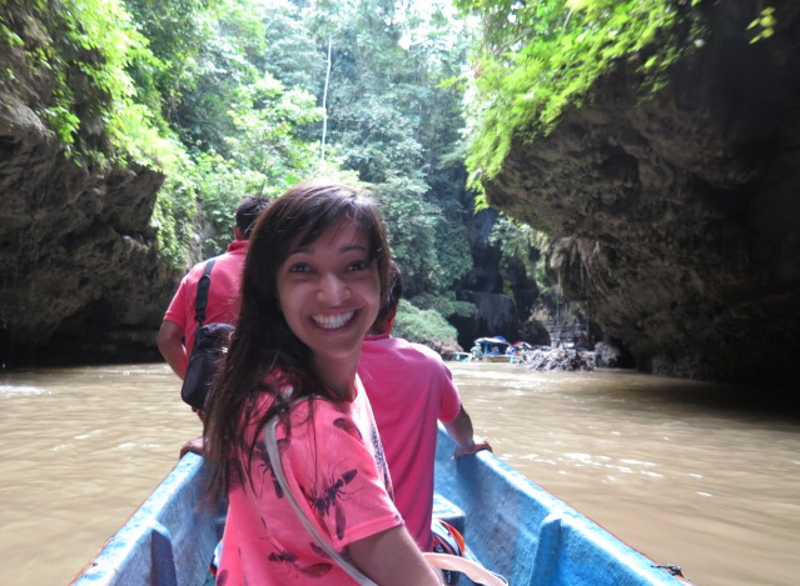

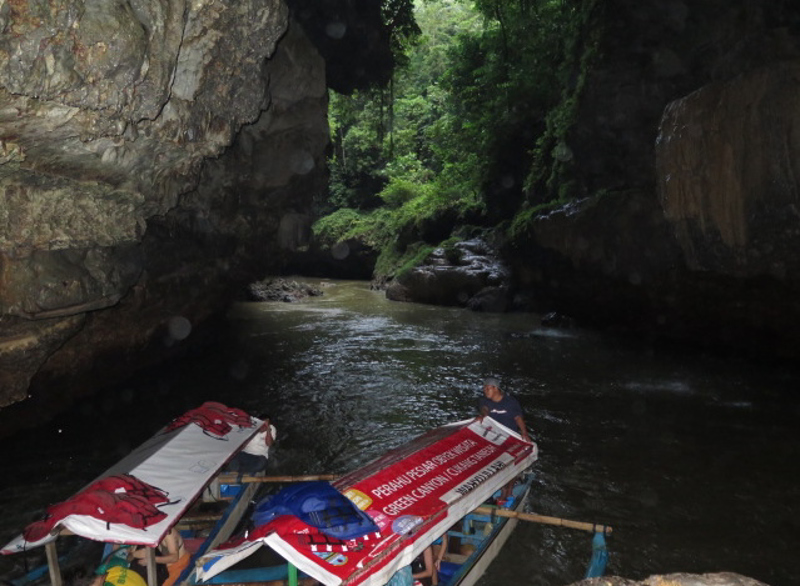

Day 5 - 3 May 14
We spend the day idly strolling the beach, and swimming in the waves. I am not out in the sun for long yet I still manage to burn myself, despite the factor 50 suncream. I hadn’t realised the sun’s strength so close to the equator. The German girls from the previous day join us. A group of 18 year olds approach us where we are seated in the shade - school kids on a trip who want to practice their English. They are entertaining and very sweet, constantly checking that they are not disturbing us and asking some amusing questions, one of which is 'why do foreigners sleep in the sun?' I feel a little stupid sitting there with my chest burnt and am unsure how to answer. The most confident boy is their spokesman, but one of the girls also speaks some English to us, covering her face with her hand and headscarf, giggling in embarrassment.
We watch the sunset on the beach with our coffee - the clouds shaped like the ash cloud from a volcano surrounded by the molten lava of the sun. Bats circle far overhead.
We eat in a small local restaurant. Cap Cay - a large bowl of crunchy vegetables cooked in a tasty chicken broth. Stevie (a friendly American girl from the hostel) spots us strolling back along the beach in the dark and shouts across to us. We join her and a few others at a table on the beach for a beer.
Continuous lightning strikes light the sky - repetitive flash images of the earlier sunset as the clouds have retained a similar form. A bat flies a metre above my head - its wings lit by the bar's lanterns.
Day 6 - 4 May 14
I choose banana pancake with chocolate sauce for breakfast, which is included in the hostel’s price, before a morning swim in the ocean. A few of us join for lunch to say goodbye to Stevie who's travelling back to Bandung where she is currently working on a research project. For lunch, we eat chicken and salad sandwiches at a cafe called Relax. Everyone else has been travelling for much longer so they are super excited by the Western food.
In the afternoon, we head to the national park on the peninsular. We decline the offer of a tour and wander the jungle paths, exploring the caves. Our surroundings are alive with the sounds of the jungle. The monkeys, who inhabit the park, are territorial of their home. Oliver's water bottle is snatched out of his hand - the thief gleefully drinks from the bottle and discards the remaining water to leak down the path once he's enjoyed his full. Deer and peacocks wander through
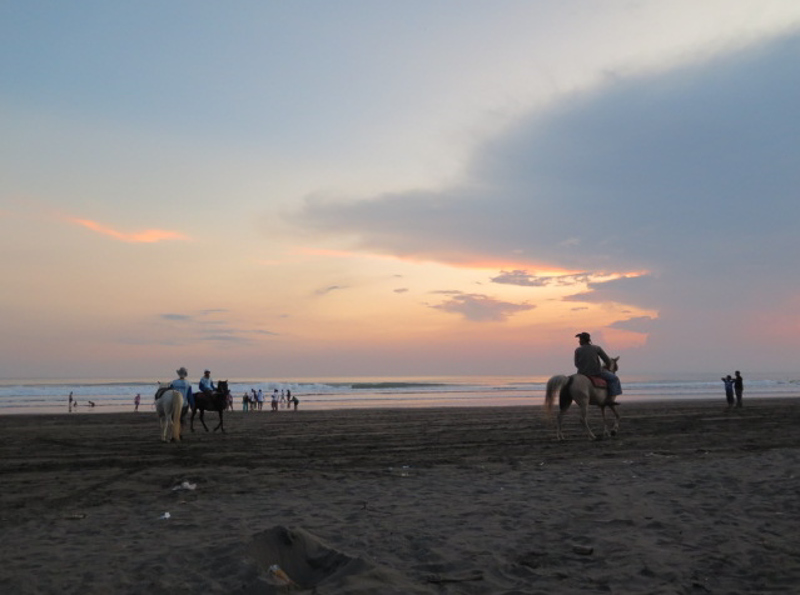
the trees. We stop at the white beach. It is full of Indonesian tourists snorkeling in the shallows with their life vests. I go for a quick swim as the sun sets.
We finish the evening sharing a massive fresh fish at the fish market. It’s not the most attractive of settings but the food is delicious. On the road on our return to the hostel is a warning road sign for a tsunami - an ominous reminder of the almost forgotten disaster.
Day 7 - 5 May 14
We eat a pancake breakfast and leave the hostel by 7 am, catching the bus to the harbour in Kilapacung and reuniting with Matt (a traveller staying in our hostel), who has biked to the harbour, and is joining us in the boat to Cilacap. Matt has been on the road for 9 months. He has already cycled through half of India, but he plans to return to
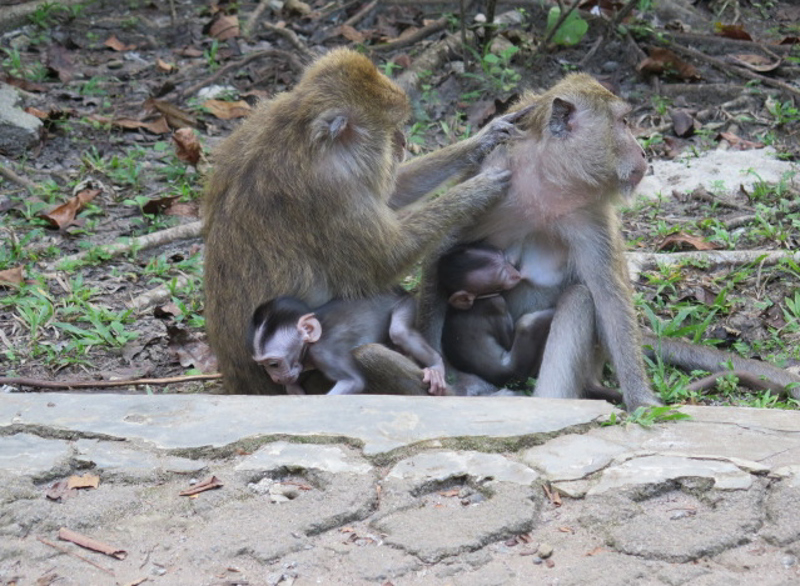

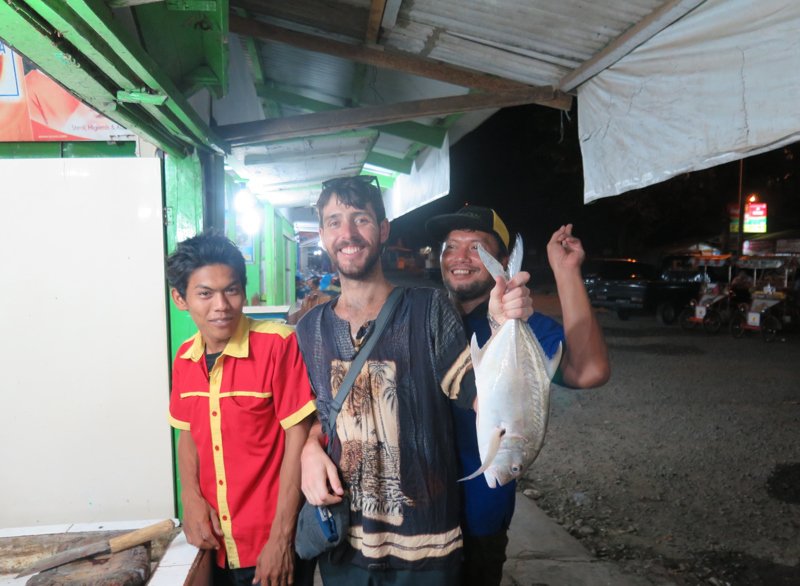
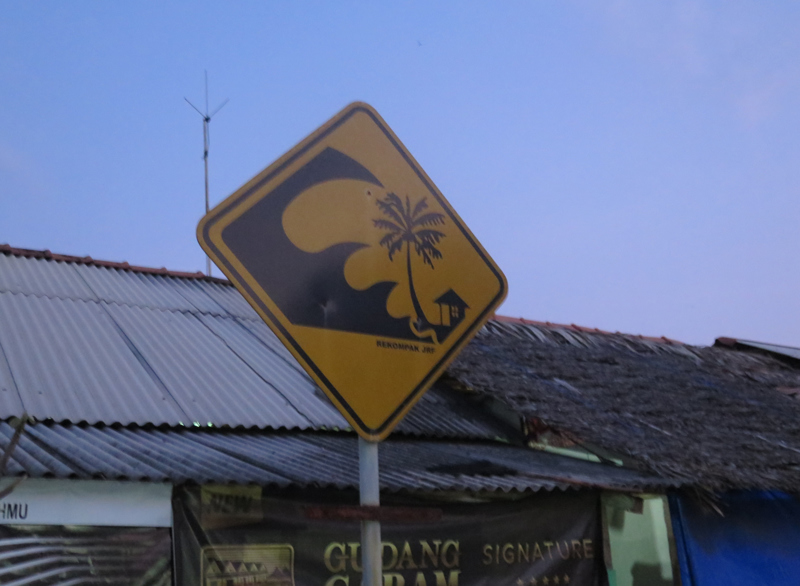
Australia soon as he has received a potential job offer in geology.
The boat is a little expensive to charter, but it’s much more interesting than the bus. It is a 4 hour journey through the mangrove swamps. We sit in the shade of the plastic canopy and the breeze produced by the movement of the boat is very pleasant, but it is impossible to chat over the chugging of the ancient engine. The backwaters are peaceful - we pass very few boats and fishermen. The wide channel cuts through the tall green plants, which grow out of the water on both sides.
We are nearing Cilacap. In the distance, 2 flames burn like Olympic torches in a smog filled landscape of spires - the industrial part of the city. A few large cargo ships lay stationary in the port as we enter. We have lunch before leaving Matt who continues his cycling journey through Java.
Once we reach Jogjakarta, we wander the backpacker area and settle for Dewi Homestay, as the other recommended hostels are full. The room is large and clean with a four-poster bed and mosquito netting. We eat at the street market - fried chicken and chicken soup.
Day 8 - 6 May 14
The breakfast consists of a scrambled egg sandwich and a plate of fruit. The courtyard in this homestay feels peaceful, despite its
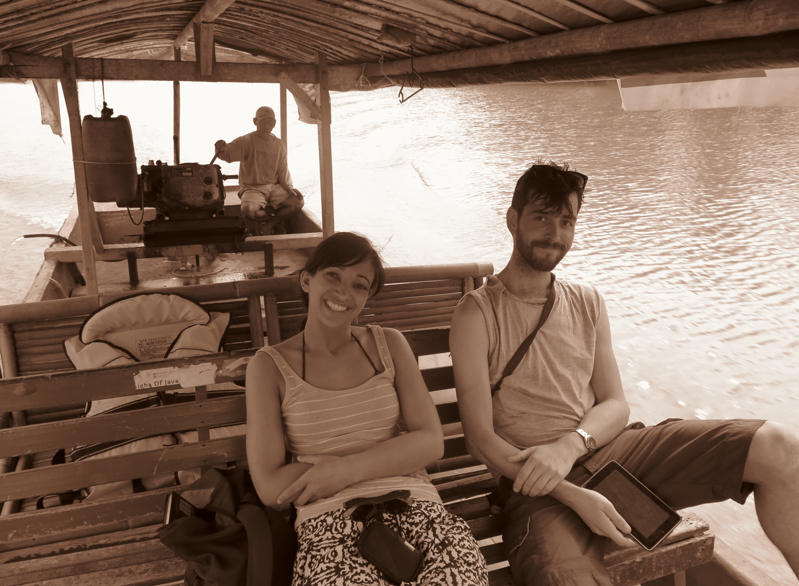
location. We stroll to the Sultan's Palace, but apparently it is already closed - we are redirected to the art centre where batik art is made. I fall for the sales pitch and buy 2 small pieces. One is of a jungle scene, depicting colourful animals - a present for my niece.
We head back to the hostel and rent 2 bikes, as the lonely planet suggests we can cycle to Prambanan temples. We decide to take the shortest route, as we don't have a detailed map. This turns out to be a complete disaster! The roads are swarming with fast-moving mopeds and cars. The road we are taking soon turns into a one-way system, but we are told that on a bicycle we are still allowed to ride on the left against the oncoming traffic. Watching mopeds speeding towards us as we cycle in the opposite direction is terrifying. We are once again travelling in the same direction as the flow of traffic, but now a flyover joins the road and it widens. After cycling for sometime we stop at a restaurant on the side of the road to double check directions. While we are talking, Hannah's bike falls over and the cogs cut into her leg. We wait until the bleeding stops and enjoy a cup of tea. As the realisation sinks in that we are on a dual carriageway with no helmet to protect us, Hannah rationally decides it is too dangerous to continue cycling so instead we walk. It is 4 km to the temple and we have already accepted that we will miss the temple closing time. We are happy just to see the Ramayana ballet. We walk along the side of the road kicking up dust, which sticks to our sun-creamed, sweaty legs. The sun is setting behind us. Upon reaching the venue, we park our bikes and eat dinner at the side of the road - cap cay and noodle soup.
We are worried as to how we will return home with our bikes. Neither of us are prepared to cycle the same route back in the dark and 20 km is too far to walk. After purchasing tickets for the show, we try asking coach drivers if they will be heading back into the city and whether they have room for our bikes. We know it's a long shot but we are desperate. It really is a testament to the kindness and helpfulness of the Indonesian race that we have experienced more and more since arriving in this country. If someone is unable to help you, they will do everything they can to find someone who can. Eventually, with the help of a driver who speaks English, a lift has been arranged for us on the same bus that will transport the dancers at the end of the show.
Sitting behind the open-air theatre are the Hindu temples all lit up - it really is a stunning location. We read the plot before the ballet begins so we are able to follow the show. It is an epic - an adaptation of a repeated storyline, not dissimilar from the myth behind Homer's Illiad. A man kidnaps another man's wife and the husband wins her back - there is adventure, metamorphosis and battle.
A singer narrates the story to the audience in Indonesian (or so we assume). The gamelan orchestra is made up mainly of percussion and xylophone-like instruments. There are few notes used in the music and the harmony often clashes by Western standard. The music is fairly repetitive but it's atmospheric and fits the dance scenes and actions that it accompanies. The costumes are colourful and the masks dramatic. The dance itself is flat footed with the feet pointing outwards. The ankles and knees bend in unison. Much of the movement is directed from the elbows, as the hands pivot around the wrists. The whole effect is slightly robotic. The synchronisation of the dancers lacks precision.
Comedic moments occur within the performance, similar to the simple wit you would find in a pantomime. At any rate, it has the Indonesian audience members laughing but is slightly lost on us. There is a dramatic fire show during the battle, in which a palace is burnt to the ground within the story. Unexpectedly, the monkey character actually lights the haystacks behind the stage with a burning torch in order to realise the scene. The haystacks leap up in towering flames. We can feel the heat from the fire despite our distance. It's a stunt that wouldn't get past the health and safety checks in a show in England!
Once the show is finished, someone is waiting to lead us to our transport. We are incredibly thankful. The bus drops us and our bikes, in the south of the town. It is late and the roads are quieter now. Using our head torches we cycle back to the hostel. The way takes us through the Sultan's palace grounds. We pass a square, which looks like a fairground. Colourfully lit outlines of toy-like cars are being peddled by teenagers around the road. My favourite are those that resemble Volkswagen Beetles. The visual effect is reminiscent of the inside of a computer game, as pictured in Tron the movie.
Day 9 - 7 May 14
To get to Borobudur we take 2 buses to reach Jombor bus terminal. We wait for a long time for the bus, but when it finally arrives it is too full for us to get on, so we have to wait for a second, which makes me irrationally angry. At Jombor, we catch the bus to Borobodur. We share the cost of a guide with 2 Singaporean students. The guide shows us some fascinating, old photographs taken not long after the site was first discovered, near the end of the 19th century, in which the majority of the temple lies beneath the mud. In the late 20th century, after considerable damage due to earthquakes, there was a major project set up to take apart, lay proper foundations and reconstruct the stones. It must have been an impossible jigsaw puzzle.
The temple itself has an incredible amount of detail. Each level is surrounded by intricate friezes, many of which depict stories of Buddha, as well as animal scenes. My favourite carving is a quadriptych, which tells the story of a giant turtle saving a group of people from a hungry crocodile in the water. The last stone shows the turtle being thanked by the grateful survivors.
At the top are the circular layers of stupas, each housing a Buddha sitting inside, which can be seen through the diamond shaped grating cut into the rock of the stupa. One Buddha is uncovered and makes for a pretty photo with the back drop of jungle and mountains. Smoke from a fire in the distance adds a mystical effect.
The temple is teeming with Indonesian students, many of whom giggle as we walk past - apparently they won't have seen foreigners in

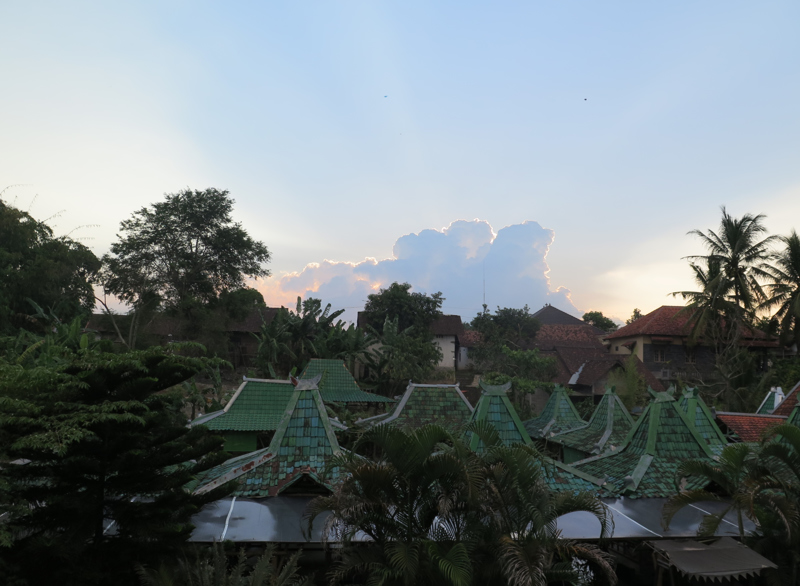
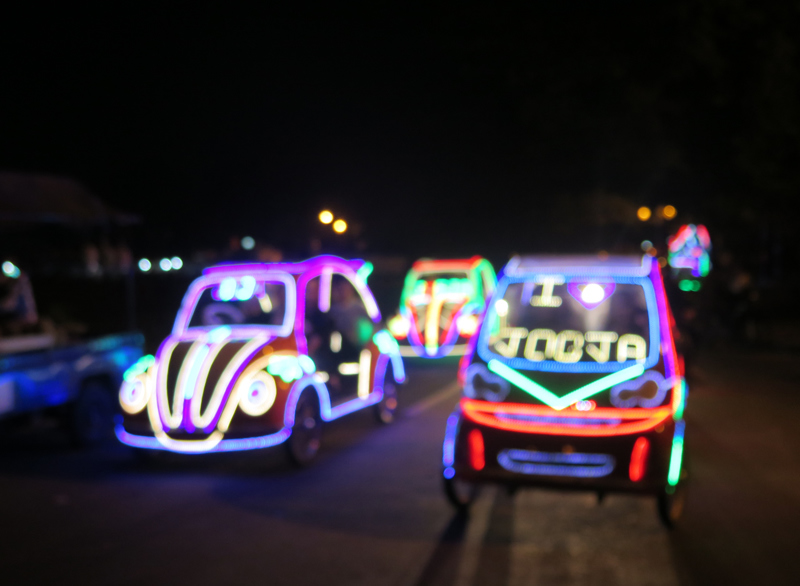
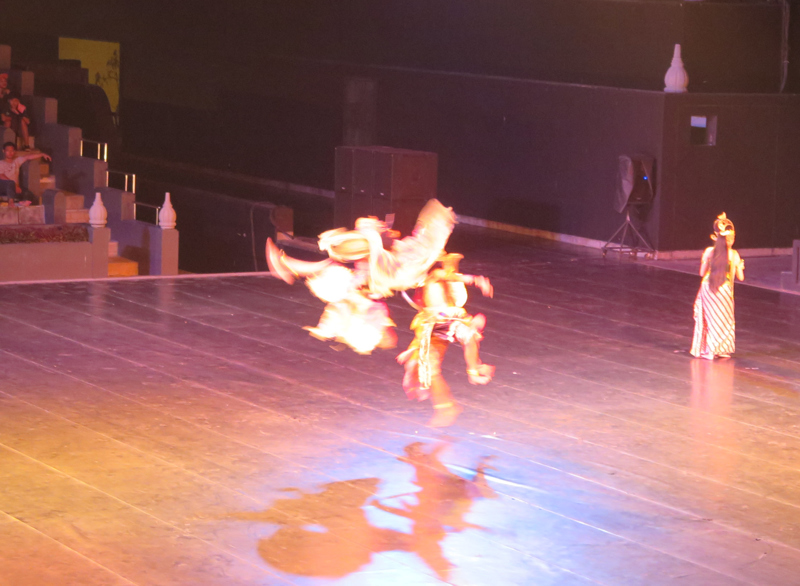
the flesh before. It is hardly a spiritual experience, due to the noisy crowds, but we appreciate the beauty of the temple nonetheless.
We eat by the bus stop with the Singaporeans and return via the public buses, but the journey is much easier. We collect our clean laundry and then head to the train station to buy tickets for the following morning. We eat a quick Mie Goreng from the stall over the road. The vendor kindly brings it into our hostel and returns to take our dirty plate.
Day 10 - 8 May 14
In the morning, there is confusion regarding the cost of the room. The lady had agreed to 170,000 IDR on the first night, but she is adamant that the price is 200,000 IDR. We don't have time to argue, so we pay the additional money. We take a taxi to the train station,


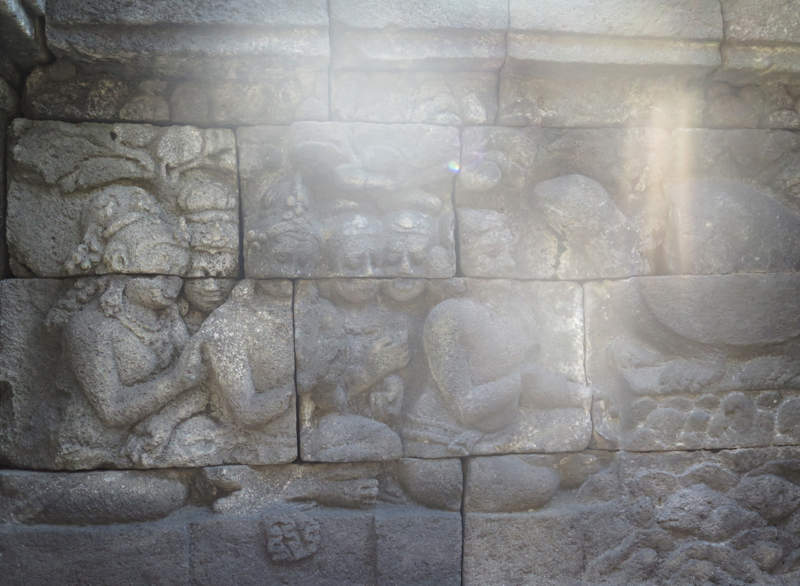
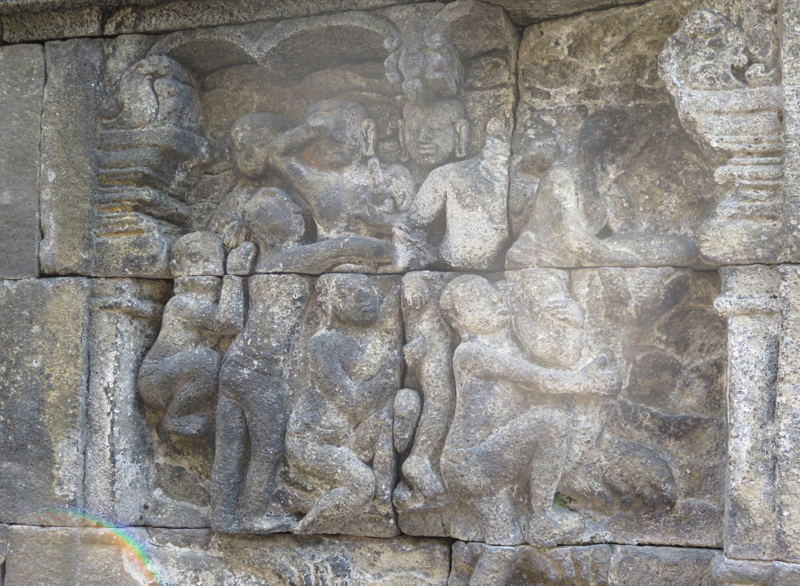
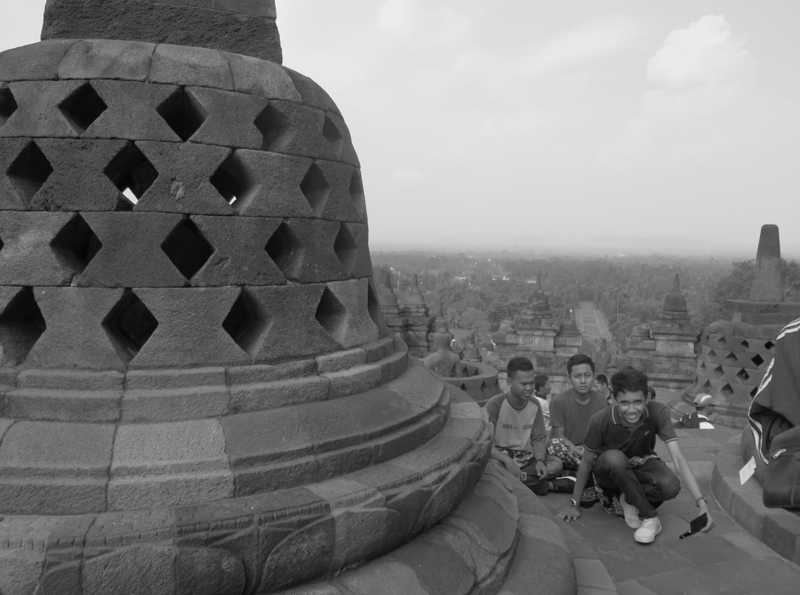

reaching the train just before it pulls out of the station. The hostel owner has kindly packed up our breakfast – we eat our egg sandwich and bag of sticky fruit on the train.
We're travelling economy class. The seats are upright and despite the attempt at AC, it's very hot. We read on the journey, dozing off intermittently. We change at Surabaya and buy a ticket onto Malang, but there are only standing tickets available and it's an extra 3 hour journey. On the train, a few Indonesian men share their seats and food. They are laughing raucously, probably at us, or the situation. They seem to find Hannah's name especially amusing, repeating it a few times. As we pull up at a station Hannah tries to take a picture out of the grimy window of the picturesque silhouette of a mosque against a blood orange sky. Ever helpful, one man spends time trying to open the window so she has a clear view for her photo.
Kampong hostel in Mandal is located at the top of a hotel on the rooftop, with huts built from bamboo and wood and large potted plants, neatly laid in rows. We drink a beer and eat a fruit salad. In the travel agency downstairs, we try to decide whether we can afford the costly tour to hike the highest volcano in Java (Mt Semeru).
Our dormitory is located in a large hut on the top of the roof - the single bunks criss-crossed four storeys high, set against the rafters, all made from thickly cut dark wood. There are also 4 double bed bunks and a triple bed in the centre with a mosquito net that we are jealous of since the room is open to the elements. We hope the mosquito spray and Malarone pills will be sufficient to keep malaria at bay as we bed down.
Day 11 - 9 May 14
We spend the morning on the rooftop discussing plans. The owners have created such a relaxing vibe that it's difficult to pull ourselves away from this mini oasis. At midday, the travel agency offers us a discounted tour price, but it's still a lot of money, so we need time to make a decision.
Malang, situated at a slightly higher altitude, is a pleasant temperature. Trees are planted all along the streets, lined with colonial buildings. We cross a bridge with a pretty vista of the leafy canal - a man is washing naked in the water. We walk through the bird and flower market. Seeing so many animals unhappily trapped in tiny cages waiting to be sold saddens us, but the flower market is prettier than any garden centre in England. We wander into a neighbourhood and soon become entangled in the narrow backstreets. The friendly occupants smile as we pass, although they are probably wondering at our nosiness. It is clearly a poor area, but a great amount of pride has been taken in the appearance of their homes. Empty water bottles have been cut in half, painted in colourful patterns and used as plant pots, which are hung along the walls of the alleyways. The little houses are painted in bright colours. A lady hands me a baby bird to stroke - its feathers are fluorescent pink, dyed when it was still a chick. We are shown down steps to the low banks of the canal, in which they wash.
Back on a main road we try to find food to eat. I order Nasi Goreng from a street stall - it does not look appetising and after I locate 2 ants amongst the rice within 3 spoonfuls of food, I discard it.
We go to Nuansa Fajar for a massage today. It is only 30,000 rupees. This training centre employs blind masseurs only, so it's not necessary to cover our bodies with a sheet. They walk carefully around the bed to massage both sides of the body and feel to locate the correct body parts. The massage is hard, especially on the calves - it is more painful than relaxing. I leave feeling that some of the knots in my muscles have been kneaded away.
Back at the hostel we are about to pay for the tour, but we meet a guy from Belgium who has just returned from climbing Mt Semuru alone. He tells us that the trekking itself is tough but he is convinced that if we head to Ranu Pani we will easily be able to find a tour guide and porter who can take us up the volcano for a much cheaper fee. We decide to risk this and apologise to Henry at the Helios Tours who now has to cancel the guide and porters that are ready to take us the next morning, feeling a little guilty.
The Singaporean guys that we met on our tour at Borobudur are staying in the same hostel - we chill out with them in the evening with a cup of green tea before bed.


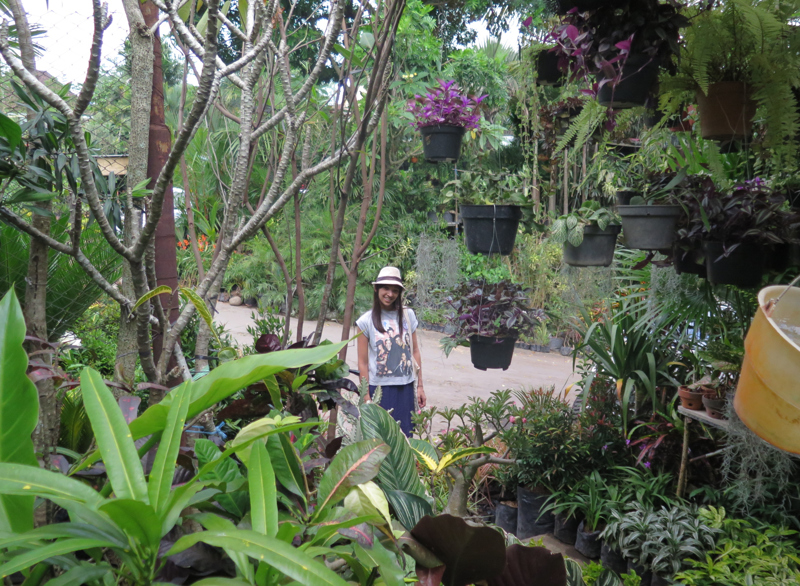
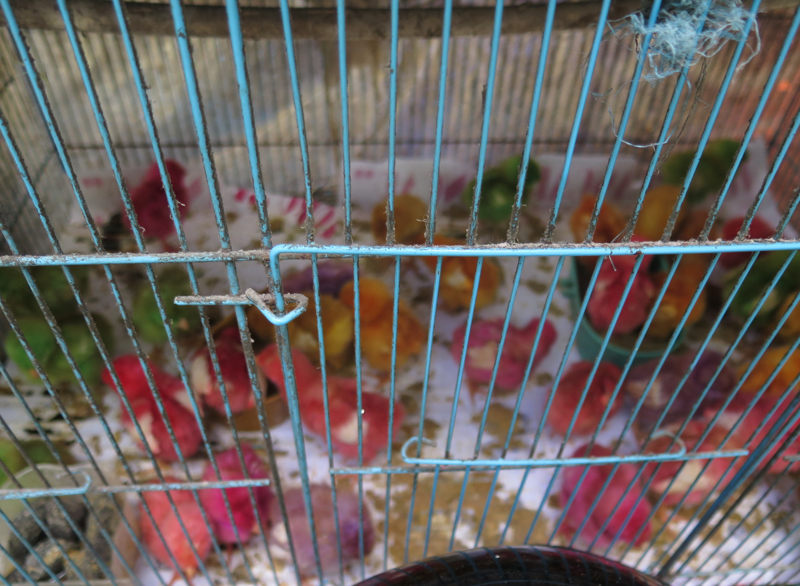
1.
Arrival in Jakarta, Pangandaran, Jogjakarta, Malang
2.
Volcanoes - Mt Semeru, Mt Bromo, Mt Ijen
3.
Ubud - a brief Sojourn
4.
Gilli Trawangan - white beaches and turquoise waters
5.
Boat Cruise - past the Komodo Dragons
6.
Flores - traditional villages and Mt Kelimutu
7.
Kuta, Lombok
8.
Baliem Valley - trekking in the mountains and meeting the Dani tribes
9.
Sentani - the festival and the lake
10.
Tana Toraja - Funerals and Burial Sites
11.
Kuala Lumpur - back in civilisation
12.
Cameron Highlands - trekking and tea plantations
13.
Georgetown, Penang - street art and crumbling mansions
14.
Banda Aceh and Pulau Weh - contending with Ramadan; Scuba Diving and snorkelling in paradise
15.
Lake Toba - the Batak people
16.
Bukit Lawang - Orangutans
17.
Unawatuna
18.
Volunteer Sri Lanka - Week 1
19.
Volunteer Sri Lanka Week 2
20.
Kandy and the East Coast
21.
Ella and Colombo
22.
Volunteer Sri Lanka - final week
23.
Earthbound Expedition - Kathmandu, Poon Hill and Chitwan National Park
24.
Back in Kathmandu
25.
Langtang - solo trekking
26.
Kathmandu to Varanasi
Share your travel adventures like this!
Create your own travel blog in one step
Share with friends and family to follow your journey
Easy set up, no technical knowledge needed and unlimited storage!
© 2025 Travel Diaries. All rights reserved.